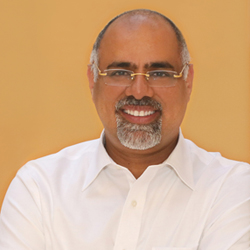We are all about connecting people, says Mastercard’s Global Chief Marketing and Communications Officer, Raja Rajamannar.
How has Mastercard’s marketing vision changed to connect with a broad audience?
The velocity of technology’s evolution has created huge opportunities for brands to build more meaningful connections with consumers. We recognise this opportunity to connect with consumers in a way that turns marketing into a force multiplier for our brand and business.
We have re-engineered our efforts internally so we can provide more value to the connected consumer. We accomplish this in four ways: By understanding what matters most to consumers; positioning our brand so it aligns with what consumers are passionate about; integrating every part of our business around connecting with consumers; and building a platform that translates the brand into personal experiences. As a result our brand positioning has moved from being transactional as “The best way to pay”, to more experiential “Connecting people to priceless possibilities”.
How have you moved the Priceless approach from an advertising campaign into a scalable marketing platform?
Our ‘Priceless’ advertising campaign began 20 years’ ago with a story about a father and son. Throughout the years, we have celebrated precious moments in people’s lives through storytelling. Storytelling, which has been effective for so long, is now dead.
Today, consumers are connected 24/7 and brands are now operating in an ‘expectation economy’. Research shows that consumers value experiences more than material goods, and that shared experiences connect us deeper to other people than shared consumption.
"Storytelling, which has been effective for so long, is now dead."
As the world becomes more experiential, every person alive today is a natural story-maker. The desire for amazing experiences is bottomless. It’s not enough to tell stories about priceless experiences. We need to align the stars for our consumers and help them create their own.
With ‘marketing 4.0’ being our strategic framework, we evolved our brand’s role from observing ‘priceless’ moments to enabling priceless experiences. Based on research we identified nine key passion categories: shopping, sports, entertainment, culinary experiences, travel, philanthropy, music, arts & culture, and environment. To provide focus and maximise the return on our efforts, we created a simple and efficient architecture comprised of four platforms: ‘Priceless Cities’, ‘Priceless Surprises’, ‘Priceless Causes’ and ‘Priceless Specials’.
How has digital changed not just the public look of Mastercard but also the internal teams that power its marketing?

For the First time in 20 years, Mastercard launched a new global rebranding and visual identity. The rebranding addresses how our brand engages in the ever-changing digital landscape while preserving the integrity and equity of the brand. The new branding now elevates the brand to a more contemporary, modern and digitally optimised brand that is easily recognisable.
Internally, we are merging the culture of classical marketers with the digital native culture to capitalise on agility by leveraging analytics and insights.
How does Mastercard demonstrate that businesses can do good and benefit their bottom line?
Giving back is a major passion area for our consumers and it’s in the DNA of the Mastercard culture. Through ‘Priceless Causes’, we use our technology and assets to make it easy for consumers to contribute to their favourite causes while doing everyday things. This enables fundraising for the cause while also driving our business objectives.
Together with Stand Up 2 Cancer (SU2C) we created ‘The Priceless Table’, a model that connects consumers around their passion for philanthropy and culinary cuisine by using technology, PR, sponsorship and SU2C partnerships. All proceeds were donated to SU2C.
We also partnered with the World Food Programme to raise money for school meals for hungry children. We activated a campaign whereby consumers just need to choose their Mastercard at the point-of-sale and we will make a contribution. As a result, we were able to feed over 40,000 children for a year in Rwanda.
This article was originally published in Marketing Week. You can find the article here.
